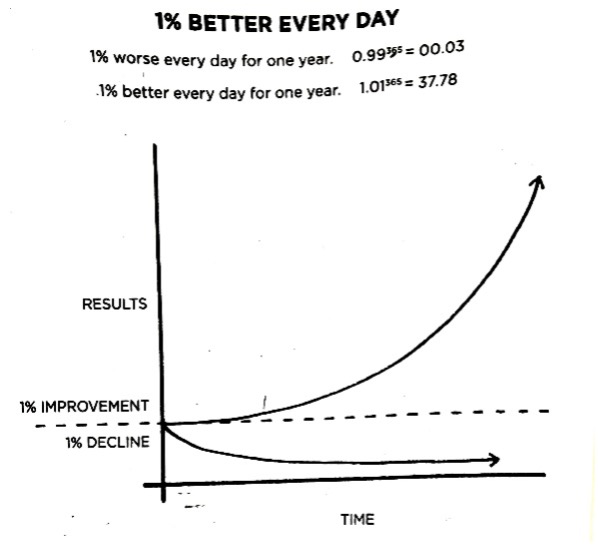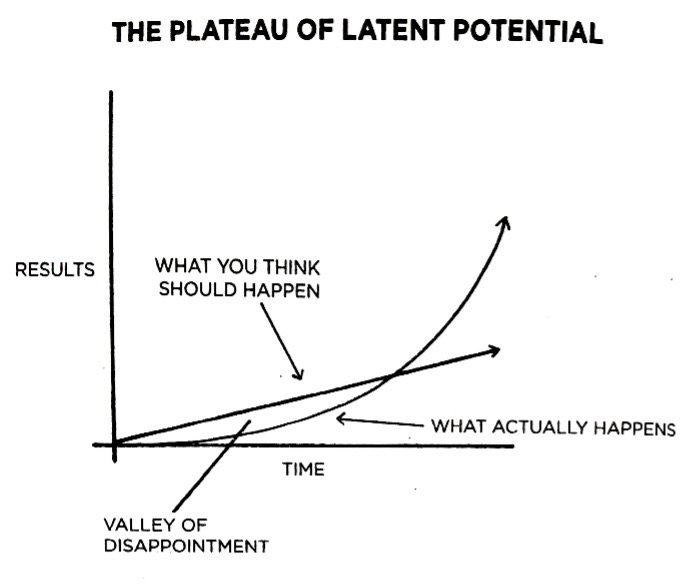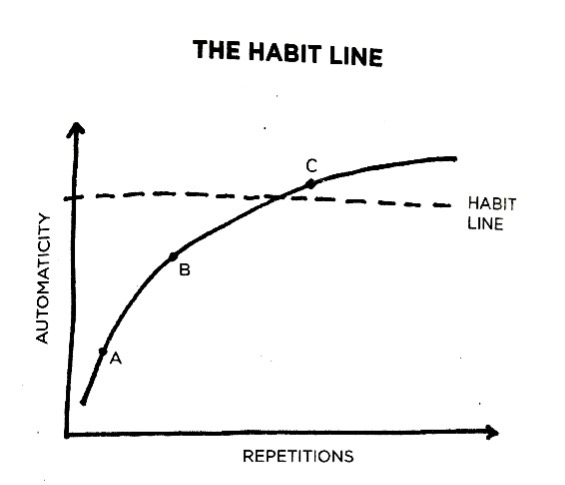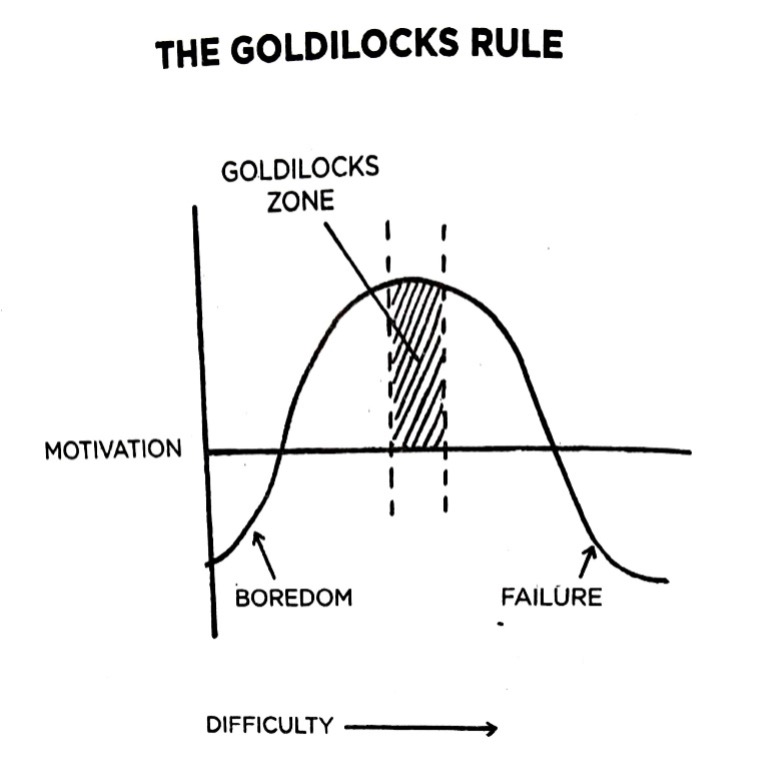This non-fiction book helped me learn about habits, their patterns, how to build good habits, and break bad ones methodically. It clearly states that tiny changes lead to remarkable results. This book will benefit anyone and everyone, irrespective of their age or profession. Anyone who wants to make the best of each minute and put it to good use, explore, and learn more can make use of this book and apply every concept it widely covers. Happy reading!
The book in 3 simple sentences
Habits can significantly improve if we just make a 1% improvement each day. A habit is a routine or a behavior that is performed regularly or automatically.
Habits are the compound interest of self-improvement – the little changes we make each day accumulate over time to create a groundbreaking change. You get what you repeat.
Habits are not about having something, but about becoming someone. Satisfying consequences lead to habits and unpleasant consequences result in unrepeated actions.
The 1% improvement strategy
This rule states that if we improve our task by 1% every day for one year, we will end up 37 times better by the end. This is called the “aggregation of marginal gains” strategy. This applies to mistakes too. If we make the same error repeatedly it will lead to a toxic result. Similarly, good habits will be compounded or accumulated by the end of it. A 1% change isn’t noticeable, but the accumulation of it is.

Breakthroughs frequently stem from a culmination of prior actions, accumulating the necessary potential to trigger significant change. Success emerges from consistent daily habits rather than relying on singular transformative events. Habits aren’t visible until they cross their threshold. Therefore, it requires not one but continuous, repeated efforts to see the fruit of success. Habits need to persist until they break through the “plateau of latent potential”.

The work until it crosses this plateau isn’t wasted but is being stored; not until much later will the full value of all the efforts be revealed.
Focus vs System
Goals are the result | System is the process that led to the result |
Goals set the direction | System is about making progress in the direction set by goals |
Goals are always present, but only when there is a system of continuous small improvements can the outcome be achievable.
Without having a strong system, the process is like treating a symptom without addressing the cause.
Fixing inputs will automatically fix outputs.
The level of dedication to the process directly influences the pace of progress.
This is the system of atomic habits: We never rise to the level of our goals. We fall to the level of our systems. Consistently engaging in small and manageable practices or routines serves as a source of strength, forming an integral part of a system fostering compound growth.
Behavioral change-layers
1st layer- Outcome: Changing the result. Most goals set are associated with this layer.
2nd layer- Process: Changing habits and systems. Most habits are associated with this layer.
3rd layer- Identity: This is the deepest layer. Changing our beliefs, worldview, judgements etc. All our beliefs and biases are associated with this layer.
Outcomes are what we get, the process is what we do, and identity is what we are/believe. Most people focus on outcomes and get a less desirable result. The problem is always the direction of change. Instead of focusing on outcome, we need to focus on identity-based habits. So now we focus on who we wish to become instead of focusing on what we wish to do.
When someone asks you to smoke, instead of saying “No thanks. I’m trying to quit”, try saying “No thanks, I’m not a smoker”. It’s a small change but makes all the difference. In the first statement it establishes you as a person who is trying to quit smoking, but in the second statement it establishes you as a person who is not a smoker. That is the affirmation your brain needs to form your identity. Never recognize your old identity because it will sabotage the new identity you are trying to achieve.
Every set of actions is underpinned by a set of beliefs. Changing your habits requires addressing the underlying beliefs that influenced your past behavior. Now there is a new goal and plan, so it’s better to establish yourself with a new identity. Saying something like you are a person who is trying to achieve this is entirely different from saying you are this person. Your identity begins from your habits/repeated beingness.
The science of habit
Every habit depends on the 4-step pattern. The first three make the behavior happen, but the last one aids the behavior to be repeated. With the reward, the feedback loop of habit closes and completes the habit cycle. These 4 stages are together called the neurological feedback loop or habit loop. These can be split into problem (first two) phase and the solution (last two) phase. We decide if a change is needed using the cue and craving, find a solution using the response and reward, where we act.
1st law Cue | Make it obvious | It is something that predicts a reward |
2nd law Craving | Make it attractive | It is the motivational force behind every habit |
3rd law Response | Make it easy | It is what you perform/activity/habit you do |
4th law Reward | Make it satisfying | It is the end goal of every habit |
For example – Walking into a dark room (cue/problem) – want to be able to see (craving/problem) – flip the light switch (response/solution) – ability to see (reward/solution).
We can apply the 4 laws for good habits and use the inversion of the 4 laws to break a bad habit.
Inversion of 1st law Cue | Make it invisible |
Inversion of 2nd law Craving | Make it unattractive |
Inversion of 3rd law Response | Make it difficult |
Inversion of 4th law Reward | Make it unsatisfying |
The 1st law: Make it obvious
This first method called “pointing and calling” is used in rail safety systems in Japan. It enhances awareness, shifting a habit from being unconscious to becoming more conscious. It is where we loudly say out every task we perform or are supposed to perform so that we become aware of our actions.
The second method is the “habit scorecard”. This is where we add or minus a point for every positive or negative task we do. Like taking a shower (+1), high screen-time (-1). This creates an effective method to monitor our overall list of tasks performed and helps to keep a check on it if we spiral out of control.
Time and location serve as the most prevalent cues. For example: “when situation X arises, I will perform response Y”, “I will [behavior] at [time] in [location]”. This method of ‘implementation intention’ makes the task so specific and obvious that it leaves us with no vague actions. The best approach of implementation intention is “habit stacking”. This is derived from ‘Diderot effect’ where one action leads to another. The best way to build a new habit is by stacking it with an existing habit. “After [current habit], I will [new habit]”
Environment > Motivation: Environment is an invisible hand that shapes human behavior. Visual cues are the greatest catalyst of our behavior. If a place is linked to a specific task, we always proceed to do that one task in that place. One space, One use. A stable environment where everything has a place, and a purpose is where habits can easily form.
Self-control: Cue-induced wanting is the external trigger that causes craving to repeat bad habits. Eliminating it by reducing exposure to it/making it invisible. This is the inversion of 1st The energy is reserved if we don’t resist temptation and instead change the surroundings.
The 2nd law: Make it attractive
The more attractive an opportunity is, the more likely it is to become habit-forming. The dopamine-driven feedback loop states that the anticipation of the reward (not the reward itself) leads to a spike and so does the motivation to act. “Temptation bundling” works by linking an action we want with something we need. Doing the thing we need to do leads to the thing we want to do.
Habit stacking + temptation bundling formula = after [current habit], I will [habit I need], then I will [habit I want]
Role of 3 groups: the close, the many, the powerful.
We always imitate the close –the proximity effect. Joining a culture where our desired behavior is normal behavior to build better habits – better sustenance of motivation from tribe.
Imitating the many- to be acceptable in the crowd, we always prevent being the one with standalone traits and often agree to things we usually don’t, just to fit in.
Imitating powerful- once we fit in, we want to stand out for power and prestige. “What will others think of me” alters our behavior in most cases.
Every action is preceded by a prediction. We can make hard habits attractive if we associate it with a positive experience. Highlighting the benefits of it rather than their drawbacks reprogram the mind and makes it look attractive. One should make a “motivation ritual” so that the cue becomes the motivation.
Inversion of 2nd law- make it unattractive- we can highlight the benefits of quitting a bad habit and reframe the mindset to avoid it.
The 3rd law: Make it easy
Motion vs Action: Being in motion is often confused with taking action. Planning just means being in motion, whereas executing the plan means taking action. We are in motion because it gives a false notion as we are making progress, but we are just delaying failures instead of doing the task. The key is repetition and not perfection.
Long Term Potentiation: More reps lead to an effective execution of the task, which results in betterment. Repetition is a form of change. Habits form based on frequency, not time.

Law of least effort: We naturally tend to choose the work that needs least amount of time. The idea behind making it easy is not to do easy tasks but making the process of a task easy in the moment that pay off in the long run by reducing the friction. This is called addition by subtraction or the removal of friction points to make the result effective.
Two-minute rule: The hardest part of a task is starting it. This rule states that “every habit when started must be done in less than 2 minutes”. The idea is to take the first step that leads to the next step and so on. It’s easier to continue than start.
Inversion of 3rd law- make it hard: Success is less about making good habits and more about making bad habits hard by increasing friction. The key is to make it hard to deviate from a good habit by making it inevitable. The best way to break a bad habit is to make it impossible to do. Automating habits or depending on technology to remind us of our habits can be effective.
The 4th law: Make it satisfying
Pleasure teaches the brain that a behavior is worth repeating, thus increasing the odds of habit repetition and closing the habit loop. What is immediately rewarded is repeated. However, we must be careful while choosing rewards and avoid those that conflict with our identity.
A habit tracker immediately makes a habit attractive by showing progress, which itself serves as motivation to keep going. The goal is to never miss twice in a row.
A habit contract leverages accountability as a strong action to maintain momentum. Making ourselves accountable to someone or keeping a check on our habits ensures consistency. When we know we’re being watched, we are less likely to skip a task. Attaching consequences can make accountability more rewarding.
Goldilocks Rule: Human experience peaks when there is the right amount of motivation, not too hard or too easy, known as manageable difficulty. The greatest threat to success is boredom. Habits combined with deliberate practice lead to mastery.

1st law | Pointing & calling, habit scorecard, implementation intention, environment factor |
2nd law | Temptation bundling, imitation, motivation ritual |
3rd law | Motion vs action, long term potentiation, 2-minute rule, law of least effort |
4th law | Habit tracker and habit contract |
Written by – Soundarya Shivakumar
Edited by – Yashvi Vasani
